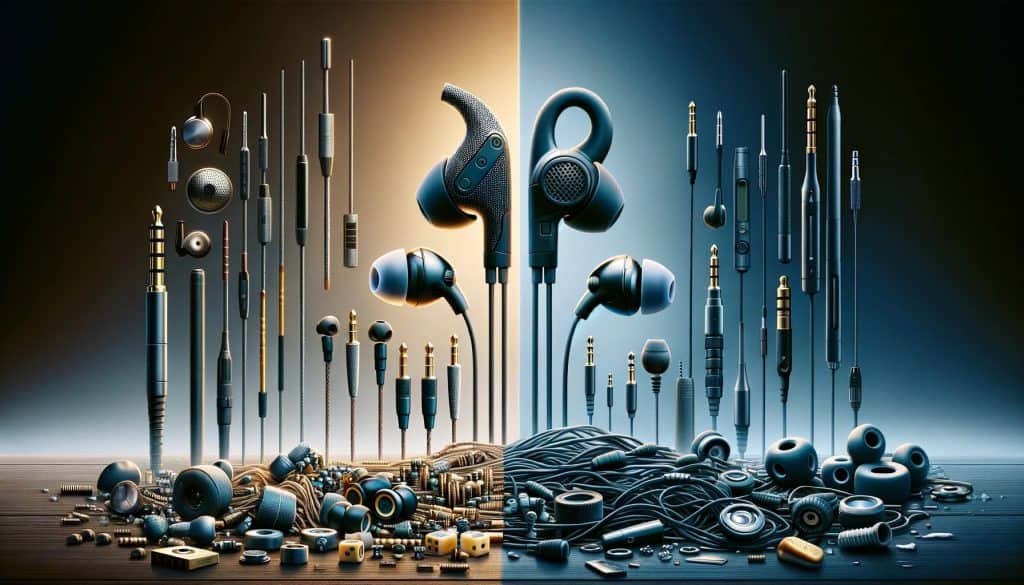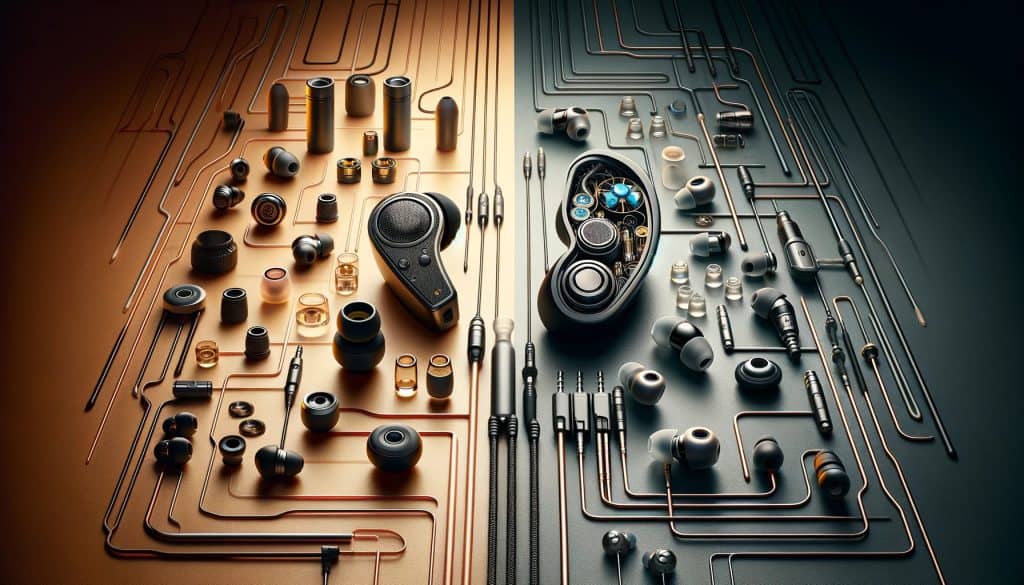In-ear monitors, originally designed for professional musicians, offer precision sound quality and noise isolation, making them a favored choice for audiophiles and professionals alike.
On the other hand, standard earbuds, with their convenience and user-friendly design, continue to be a popular choice for the everyday listener.
This article aims to delve deeper into the nuances of these two types of audio devices. We will explore their design, sound quality, user experience, and much more to understand what sets them apart and what might make one more suitable for you than the other.
Join us as we navigate the intricate world of in-ear monitors and standard earbuds, understanding their role in our ever-connected, sound-filled lives.
< class="wp-block-separator has-alpha-channel-opacity"/>What are In-Ear Monitors?
In-ear monitors (IEMs) are high-quality earphones that fit snugly inside the ear canal. Unlike standard earbuds that rest at the entrance of the ear, IEMs are designed to be inserted deeper, creating a seal that isolates sound.

This design provides a direct audio path to the ear, delivering clearer, more detailed sound. They often come with various ear tips to ensure a comfortable and secure fit for different ear sizes.
IEMs are known for their exceptional sound clarity, enhanced bass response, and noise isolation capabilities.
The sound isolation is not just about blocking outside noise; it also means less sound leakage, ensuring a private listening experience. Advanced models can even offer customized sound profiles and built-in equalizers.
Typical Users and Applications
Initially designed for musicians and audio professionals, IEMs have found a broader audience. They are now widely used by:
- Musicians and Performers: For clear, isolated sound during live performances and studio recordings.
- Audio Engineers and Producers: For detailed sound analysis and mixing.
- Audiophiles: Those who seek high-fidelity sound for personal enjoyment.
- Frequent Travelers: For noise isolation in noisy environments like airplanes or public transport.
- Fitness Enthusiasts: For a secure fit during physical activities.
In-ear monitors cater to those who prioritize sound quality and clarity over convenience. They offer an immersive audio experience, making them ideal for critical listening, professional audio work, and enjoying music at its best.
< class="wp-block-separator has-alpha-channel-opacity"/>What are Standard Earbuds?
Standard earbuds are compact audio devices designed to sit at the entrance of the ear canal. Unlike in-ear monitors, they don’t penetrate deeply into the ear canal, making them less intrusive.

They are known for their portability, ease of use, and universal fit. Most standard earbuds are wired, though wireless versions have gained popularity in recent years.
The sound quality of standard earbuds varies widely, but generally, they provide a balanced sound suitable for casual listening. They’re not typically known for high-level noise isolation or sound fidelity like in-ear monitors, but recent advancements in technology have significantly improved their performance.
Common Uses in Everyday Life
Standard earbuds have become a staple in modern life due to their convenience and accessibility. Their typical uses include:
- Casual Listening: Ideal for everyday music listening, podcasts, and audiobooks.
- Exercise and Sports: Lightweight and easy to wear, they are popular for gym workouts and running.
- Commuting and Travel: Compact and easy to store, making them a go-to choice for on-the-go entertainment.
- Phone Calls and Virtual Meetings: Many come equipped with microphones, making them useful for hands-free communication.
- Gaming: Some models are designed for gaming, with built-in microphones and enhanced sound quality.
In essence, standard earbuds are the go-to choice for many due to their blend of convenience, simplicity, and adaptability to a wide range of everyday activities.
< class="wp-block-separator has-alpha-channel-opacity"/>Design Differences
When it comes to personal audio, the design elements of in-ear monitors and standard earbuds are as important as their sound quality. These design differences impact not only the audio experience but also the comfort, durability, and overall user experience.

Physical Build and Appearance
- In-Ear Monitors:
- Typically have a more intricate design.
- Often feature over-the-ear cable routing to secure the earpieces in place.
- Available in a variety of shapes to fit the contours of the inner ear.
- Custom models are molded to fit the user’s ear canal perfectly.
- Standard Earbuds:
- Have a simpler, more uniform design.
- Designed to rest at the entrance of the ear canal.
- Generally one-size-fits-all, though some may come with different sized tips.
- More likely to have a minimalist aesthetic.
Material Used in Construction
- In-Ear Monitors:
- High-quality materials for better sound isolation and durability.
- Often use memory foam or soft silicone for ear tips to ensure a snug fit.
- The casing can be made of plastic, metal, or even custom materials in high-end models.
- Standard Earbuds:
- Typically constructed from hard plastic.
- Silicone tips are common in models designed for a more secure fit.
- Less likely to use premium materials compared to in-ear monitors.
Comfort and Fit in the Ear
- In-Ear Monitors:
- Designed for a snug and secure fit inside the ear canal.
- Custom-fitted models provide unparalleled comfort for prolonged use.
- The seal in the ear canal can feel unusual or uncomfortable for new users.
- Standard Earbuds:
- Generally more comfortable for casual users who prefer less intrusive earbuds.
- Less likely to cause ear fatigue during extended use.
- May not stay securely in place during vigorous activities like sports.
The design differences between in-ear monitors and standard earbuds are a result of their distinct purposes. In-ear monitors prioritize sound quality and isolation, suitable for professional and audiophile use, while standard earbuds focus on convenience and comfort for everyday casual listening.
< class="wp-block-separator has-alpha-channel-opacity"/>Sound Quality and Performance
The sound quality and performance of in-ear monitors and standard earbuds differ significantly, largely due to their design and intended use. Understanding these differences can help users choose the right type of earphones for their listening preferences.

How In-Ear Monitors Deliver Sound
- Direct Sound Delivery: In-ear monitors are designed to fit deeply into the ear canal, providing a direct audio path to the eardrum. This design minimizes sound loss and interference.
- Sound Isolation: The snug fit creates a seal that isolates background noise, allowing for clearer sound, especially in noisy environments.
- High-Quality Drivers: Many in-ear monitors come with multiple drivers dedicated to different frequency ranges, delivering a richer and more detailed sound profile.
Sound Delivery in Standard Earbuds
- Outside-the-Ear Canal Design: Standard earbuds sit at the entrance of the ear canal. This design can lead to more sound leakage and less effective noise isolation.
- Single Driver Design: Most standard earbuds use a single driver to cover all sound frequencies, which may not provide the same level of detail as multi-driver IEMs.
- Open Sound Experience: The less intrusive fit can result in a more natural and open sound, which some users prefer.
Comparison in Terms of Bass, Treble, and Clarity
- Bass:
- In-Ear Monitors: Typically offer deeper and more precise bass due to better seal and advanced driver technology.
- Standard Earbuds: Bass can be less pronounced and less detailed, but recent advancements have improved bass quality.
- Treble:
- In-Ear Monitors: Tend to deliver crisp and clear high frequencies, suitable for detailed listening.
- Standard Earbuds: Highs can be less distinct, sometimes leading to a more blended sound profile.
- Clarity:
- In-Ear Monitors: Known for their exceptional clarity, especially in picking up subtle nuances in music.
- Standard Earbuds: Generally provide good clarity, but may not match the detail level of in-ear monitors.
In-ear monitors excel in delivering high-fidelity sound with excellent clarity, making them ideal for audiophiles and professionals. Standard earbuds, while not as high-performing in sound isolation and detail, offer a more casual listening experience that is sufficient for everyday use.
< class="wp-block-separator has-alpha-channel-opacity"/>Durability and Lifespan
The longevity of any audio device depends significantly on its build quality and how well it is maintained. In-ear monitors and standard earbuds, given their different design and material choices, offer varying degrees of durability and lifespan.

Lifespan of In-Ear Monitors
- Built for Longevity: In-ear monitors are often constructed with higher quality materials compared to standard earbuds. They are designed to withstand the rigors of professional use, which can extend their lifespan.
- Replaceable Parts: Many in-ear monitors come with replaceable cables and ear tips, which means that even if one part wears out, it can be replaced without needing to purchase a new set of monitors.
- Varies with Usage: The lifespan of IEMs can be significantly long, especially if they are used carefully and maintained well. However, rough handling can shorten their lifespan.
Durability of Standard Earbuds
- Varied Quality: The durability of standard earbuds can vary greatly depending on the brand and model. Generally, they are not built with the same robustness as professional-grade IEMs.
- Prone to Wear and Tear: Due to their more common use in a variety of settings, standard earbuds may be more prone to wear and tear, especially if they are budget models.
- Limited Repair Options: Unlike IEMs, standard earbuds often don’t have replaceable parts, so any significant damage might require a complete replacement.
Maintenance and Care Tips
- Regular Cleaning: Keep the ear tips clean and free of earwax to ensure optimal sound quality and hygiene. Use a soft, dry cloth for cleaning.
- Proper Storage: When not in use, store the earphones in a protective case to prevent damage.
- Avoid Moisture: Protect the earphones from water and excessive moisture, as this can damage the internal components.
- Cable Care: Be gentle with the cables. Avoid bending them at sharp angles and wrap them loosely to prevent internal wire damage.
- Safe Usage: Avoid using earphones at extremely high volumes to prevent damage to the speakers and to protect your hearing.
By understanding the inherent durability of each type and following proper maintenance routines, users can significantly extend the life of their in-ear monitors and standard earbuds.
< class="wp-block-separator has-alpha-channel-opacity"/>Price and Accessibility
When it comes to choosing between in-ear monitors and standard earbuds, price and accessibility play significant roles. These factors often influence a consumer’s decision based on their budget and what they’re looking for in terms of audio quality and usage.

Cost Comparison
- In-Ear Monitors:
- Generally, more expensive than standard earbuds.
- The price range can vary widely, with professional-grade models being quite costly.
- Custom-made in-ear monitors are at the higher end of the price spectrum.
- Standard Earbuds:
- Typically more affordable and accessible to the average consumer.
- The price can range from very budget-friendly to moderately expensive for high-end models.
- Wireless and feature-rich models may cost as much as lower-end in-ear monitors.
Availability in the Market
- In-Ear Monitors:
- Widely available t ough online retailers and specialty audio stores.
- Custom models may require visiting a professional for ear moldings and fitting.
- Less likely to be found in general electronics stores.
- Standard Earbuds:
- Extremely accessible and can be found in a variety of stores, from electronics outlets to supermarkets.
- The abundance of choices makes them easily available both in physical stores and online.
- Often included as accessories with portable electronic devices like smartphones.
Value for Money
- In-Ear Monitors:
- Offer high value for audiophiles and professionals who require superior sound quality and durability.
- For those who prioritize sound isolation and audio fidelity, the investment can be well worth it.
- The replaceable components can add long-term value.
- Standard Earbuds:
- Offer great value for everyday use, casual listening, and convenience.
- For those who want a simple, plug-and-play audio solution, standard earbuds are a cost-effective choice.
- The latest models offer improved sound quality and features, increasing their value for money.
In-ear monitors are a significant investment compared to standard earbuds, but they offer superior sound quality and durability. Standard earbuds, on the other hand, are more about convenience and accessibility, providing a reasonable sound quality at a more affordable price point. The choice between the two ultimately depends on the user’s priorities and budget.
< class="wp-block-separator has-alpha-channel-opacity"/>Pros and Cons
When comparing in-ear monitors and standard earbuds, it’s important to consider their advantages and limitations. Each type caters to different needs and preferences, and understanding these can help you make a more informed choice.

Advantages of In-Ear Monitors
- Superior Sound Quality: IEMs offer exceptional sound clarity, detail, and balance, making them ideal for audiophiles and professionals.
- Effective Noise Isolation: The in-ear design and seal provide excellent noise isolation, allowing for an immersive listening experience even in noisy environments.
- Custom Fit Options: High-end IEMs can be custom-molded to fit individual ear canals, providing unparalleled comfort and sound quality.
- Durability and Longevity: Often built with high-quality materials and replaceable parts, IEMs are designed to last longer.
- Professional Use: Ideal for musicians, audio engineers, and anyone requiring precise and detailed sound.
Benefits of Standard Earbuds
- Convenience and Portability: Lightweight and easy to carry, standard earbuds are ideal for on-the-go listening.
- Affordability: They are generally more budget-friendly, making them accessible to a wider audience.
- Universal Fit: Designed to fit most ears comfortably without the need for custom fitting.
- Ease of Use: Simple, plug-and-play operation without the need for specialized knowledge or equipment.
- Variety: Available in a wide range of styles, colors, and features to suit different preferences.
Limitations of Each Type
- In-Ear Monitors:
- Cost: Can be quite expensive, especially the custom-molded models.
- Comfort: The deep insertion into the ear canal may not be comfortable for everyone.
- Maintenance: Requires more care and maintenance compared to standard earbuds.
- Standard Earbuds:
- Sound Quality: Generally, they do not match the audio quality of IEMs, especially in terms of clarity and bass response.
- Noise Isolation: Less effective at noise isolation, which can affect the listening experience in noisy settings.
- Durability: Often less durable and prone to wear and tear, especially the budget models.
Both in-ear monitors and standard earbuds have their distinct advantages and drawbacks. The choice between the two largely depends on individual needs, preferences, and budget. While IEMs are the go-to choice for high-quality audio and professional use, standard earbuds offer simplicity and convenience for everyday casual listening.
< class="wp-block-separator has-alpha-channel-opacity"/>Who Should Choose What?
Selecting the right type of earphones – in-ear monitors or standard earbuds – largely depends on the user’s lifestyle, preferences, and what they primarily need the earphones for. Understanding the ideal user profile for each type can guide you to make a choice that best suits your needs.

Ideal User Profile for In-Ear Monitors
- Audiophiles and Sound Enthusiasts: Those who prioritize sound quality above all else and seek a high-fidelity listening experience.
- Professional Musicians and Audio Technicians: Individuals who need precise and accurate sound for performances, recordings, or mixing.
- Frequent Travelers in Noisy Environments: People who often find themselves in noisy environments and need effective noise isolation.
- Fitness Enthusiasts Needing Secure Fit: Those who require a snug and secure fit during intense physical activities or workouts.
- Users Looking for Durability and Longevity: Individuals willing to invest in a high-quality product that offers longevity and replaceable parts.
Good Suited Users for Standard Earbuds
- Casual Listeners: Individuals who need earbuds for everyday use, like listening to music, podcasts, or audiobooks.
- Budget-Conscious Consumers: Those looking for a cost-effective solution for their audio needs.
- Users Prioritizing Convenience: Individuals who value ease of use, portability, and quick access to audio.
- Non-Audiophiles: Those who don’t require high-level sound fidelity for their daily audio consumption.
- Younger Users or Tech Newbies: Ideal for teenagers or users who are not particularly tech-savvy and need a straightforward, user-friendly audio device.
Factors to Consider When Choosing
- Sound Quality vs. Price: Balance your desire for high-quality sound with your budget constraints.
- Comfort and Fit: Consider how comfortable you are with earphones inside your ear canal versus resting outside.
- Lifestyle and Usage: Reflect on your lifestyle and the primary usage of the earphones. For instance, do you need them for professional work, for use during physical activities, or just for casual listening?
- Durability and Maintenance: Think about how much effort you are willing to put into maintaining your earphones and whether you prefer a more durable option.
- Portability and Ease of Use: If you’re always on the move, consider how easy it is to carry and use the earphones.
By considering these profiles and factors, you can make a well-informed decision on whether in-ear monitors or standard earbuds are the right choice for you. Remember, it’s about finding the best fit for your individual needs and preferences.
< class="wp-block-separator has-alpha-channel-opacity"/>Future Trends
The world of personal audio is constantly evolving, with technological advancements continuously shaping the future of both in-ear monitors and standard earbuds. Staying abreast of these trends can give us a glimpse into what the future holds for these devices.

Innovations in In-Ear Monitors
- Wireless Technology: The future of IEMs includes further integration of advanced wireless technologies, reducing latency and improving connection stability.
- Smart Features: Incorporation of smart technologies like voice assistants, touch controls, and health monitoring sensors.
- Active Noise Cancellation: Enhanced active noise cancellation (ANC) capabilities, offering even better isolation from ambient sounds.
- 3D and Spatial Audio: Advanced spatial audio technologies for a more immersive listening experience, particularly for virtual reality (VR) and augmented reality (AR) applications.
- Eco-Friendly Materials: A shift towards sustainable materials in response to growing environmental concerns.
Evolving Designs of Standard Earbuds
- Improved Sound Quality: Continued advancements in driver technology to improve the sound quality of standard earbuds, making them more competitive with IEMs.
- More Ergonomic Designs: Innovations in design for better comfort and fit, catering to a wider range of ear shapes and sizes.
- Integrated Health Features: Including sensors for health tracking, such as heart rate monitors, to appeal to the fitness and wellness market.
- Longer Battery Life: For wireless models, extended battery life remains a key area of improvement.
- Customizable Sound Profiles: Offering users the ability to customize sound settings t ough accompanying apps.
Predictions for the Future of Personal Audio
- Integration with Wearable Tech: Earbuds and IEMs will become more integrated with other wearable technologies, functioning as part of a connected ecosystem.
- AI and Machine Learning: Utilization of AI to adapt sound profiles based on user preferences and listening environments.
- Augmented Hearing: Earbuds that not only play audio but also enhance or filter ambient sounds, offering a customizable hearing experience.
- Voice-Controlled Interfaces: Increasing reliance on voice commands for hands-free control and navigation.
- Sustainability Focus: A growing emphasis on sustainability in manufacturing and packaging, responding to consumer demand for eco-friendly products.
The future of personal audio is not just about listening to music or podcasts. It’s evolving into an immersive, interactive, and integrated experience, enhancing how we interact with technology and the world around us.
< class="wp-block-separator has-alpha-channel-opacity"/>Conclusion
As we’ve explored the intricacies of in-ear monitors and standard earbuds, it’s clear that each serves its unique purpose in the realm of personal audio. The choice between the two boils down to individual needs, preferences, and the specific contexts in which they will be used.

Recap of Key Points
- In-Ear Monitors: Stand out for their superior sound quality, noise isolation, and professional-grade features. They are ideal for audiophiles, musicians, and those who seek an immersive listening experience.
- Standard Earbuds: Excel in providing convenience, comfort, and accessibility. They are a great choice for casual listening, everyday use, and for those who prioritize ease of use and budget-friendliness.
- Design Differences: In-ear monitors offer a more snug fit and better sound isolation, while standard earbuds are designed for comfort and ease of use.
- Sound Quality and Performance: In-ear monitors provide higher fidelity and clarity, whereas standard earbuds offer a more balanced sound suitable for general listening.
- Durability and Lifespan: In-ear monitors are typically more durable with replaceable parts, whereas standard earbuds can vary in quality and may need more frequent replacing.
- Price and Accessibility: In-ear monitors are generally more expensive, while standard earbuds are widely available and affordable.
- Future Trends: Both in-ear monitors and standard earbuds are evolving, with advancements in technology enhancing their features and capabilities.
Final Thoughts and Recommendations
When choosing between in-ear monitors and standard earbuds, consider your primary use-case scenarios. If you are a music enthusiast or a professional requiring detailed sound, in-ear monitors are a worthwhile investment. On the other hand, if you seek a convenient and budget-friendly option for everyday use, standard earbuds are an excellent choice.
It’s also important to keep an eye on the future trends in personal audio. Innovations in technology are rapidly changing what these devices can offer, making them more than just tools for listening to music. They are becoming integral parts of our digital and physical lives, offering new ways to interact with our environment and stay connected.
In the end, whether you choose in-ear monitors or standard earbuds, the key is to find a product that aligns with your needs, enhances your listening experience, and fits comfortably into your lifestyle.


